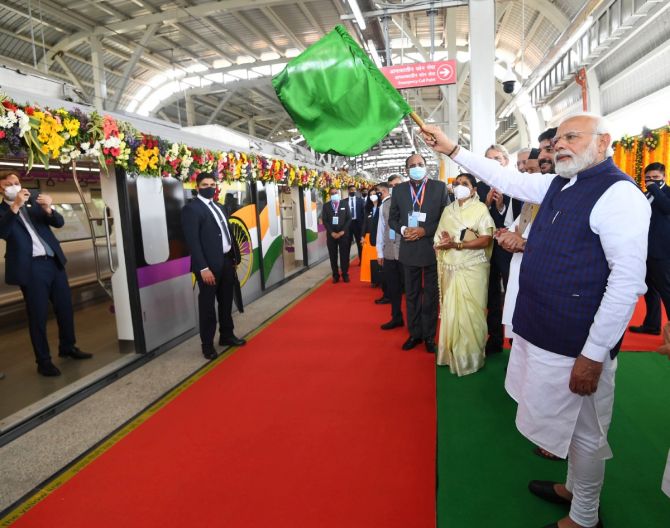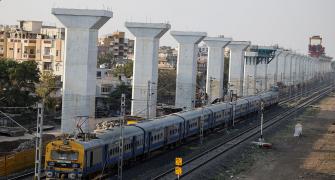'In the larger cities, we can see that 12%-20% of the population making use of the metros. I don't think it is happening in the smaller cities.'

Today, a city in India is considered modern only when the metro rail system is planned there.
So, at regular intervals, the government announces the introduction of metro rail in one city or the other, and projects it as a major achievement.
But according to a paper published by The Infravision Foundation along with Professor Geetam Tiwari and Professor Deepty Jain of IIT-Delhi, the ridership numbers of all the metros in India are far below the projections: 47% in Delhi, 30% in Mumbai and Kolkata, and just 6% in Bengaluru.
Why is it that the metros are not patronised by urban Indians?
"For large cities like Mumbai, Delhi or Bangalore, you need the metro system as around 15% of the population travel very long distances for work. That's where the metro comes in," Professor Deepty Jain tells Rediff.com's Shobha Warrier.

What was the reason behind the study conducted by you and Professor Geetam Tiwari on the metros of India?
The study was not just about the metros. The study was to develop a framework that can assist policymakers and decision makers at different levels to look at what kind of transportation is required for different kind of cities.
It is basically a guiding document for which we had looked at data from almost 232 districts of India.
We looked at the data from the 2011 Census of India to understand the travel pattern of people.
We also looked at the income distribution, and how people were engaged in different economic activities.
Then, we searched for data on where different types of transport systems were operating.
All the data came from the government reports only.

Your study said that not even one metro rail system achieved even half its projected ridership. Were you able to find out the reasons behind this?
The projected ridership is based on the feasibility report of the public transport system and our assessment is based on which income group can use a particular system.
The models are such that we generally overestimate the demand.
Any public transport system has three component to it. One, how you reach the station or stop. Two, how far you are travelling. Three, how you reach the final destination after you get out of the train or bus.
So, the demand for any route depends not just on first-mile connectivity but also on last- mile connectivity.
Because metro is a kind of a system that does not occupy road space throughout the city, you cannot reach out to 100% of the targeted population with a transport system like metro.
It has to be integrated with other transport systems too.
We proposed that for a city of 80 lakh population, an integrated system of buses and metro can help in achieving the maximum demand.

IMAGE: Professor Deepty Jain.
It is common knowledge that first-mile and last-mile connectivity is needed for a rail system to work. Could you find out why the authorities did not plan an integrated system while developing the metro?
But we do know that there is a lack of integration between two or multiple transport systems even though the national urban transport policy talks about the need to have an integrated transport system like the Unified Metro Multi-model Transport agency. What we need to do is integrate them at various levels.
That integration is not happening because each transport system is considered separate, and operated by different agencies. That's where we are lacking in.
Why is it that ridership is different in different cities? For example, a survey says that in Bangalore, metro attracts only 6% of its projected ridership. On the other hand, it is much more in Delhi.
Both the cities fall in the large size population. In Bangalore, metro is available only in less than 40 km. More than that, Bangalore needs to integrate all transport systems as that integration is lacking right now.
The main difference between Delhi and Bangalore is the working population in Delhi has never been too much dependant on cars and two wheelers.
Even before the metro came also, there was a high ridership on public transport systems.
In fact, the overall ridership in public transport system in Delhi has reduced over the years.
If you look at the motorisation rate in Delhi, it has increased multiple folds in the last one decade, and it is because of the economic growth supplemented with poor infrastructure for walking and bicycling.
When people are using their own vehicles more, it means more pollution and traffic congestion on roads...
Yes. Many studies have found that people of Delhi are using private vehicles more which is a big challenge for cities like Delhi.

What about the metros in Mumbai, a city where a large percentage of the population have been using suburban trains for many decades?
Because Mumbai is a linear city, you have long distances to travel.
If you have long distances to travel, the railway system becomes more functional.
That's why we see majority of the demand is in rail ridership in Mumbai.
Since the suburban rail system has been in existence for some time, connectivity also is better.
The existing system of suburban trains in Mumbai is patronised by a large population because it is very good in its operation, in time reliability, and in the frequency of trains.
Above all, because Mumbai is a linear city, people travel long distances.
But if you look at Tier One and Tier Two cities, for example a city like Jaipur, you will see that not many people are travelling longer distances.
If people travelling long distances are low, then the demand for a rail transport system like metro will be lower.
Do you think metros are not a favourite among the travelling public because the tickets are priced very high?
Yes. In our study, we have found that only if you are earning around Rs 36,000 a month, you can afford 2 trips a day for one person in a metro.
Many studies have found that a majority of the railway demand comes from beyond 500 metres of the public transport system.
It means you have to not just pay for the metro but for the other para transport system too.
So, if you are travelling by any railways system, your expenditure increases.

If this is the situation, how will expanding metros to 18 cities work?
In the larger cities, we can see that 12%-20% of the total population making use of the metros.
But I don't think it is happening in the smaller cities. So, you have to be careful about developing a railway system there.
In most cities in India, people do not travel long distances. I don't see any point in having metro in such cities.
If people can reach their work places by travelling short distances, those are the sustainable cities. And that should be our focus, and not making them big to have more demand.
Even in the existing system, you have to see what percentage of population travel long distances daily.
Take for example Mumbai, only 10% of the population travel longer than 10 km daily for work, and 42% of the population travel shorter than 2 kms.
Nowhere in the world, it happens. That's how a sustainable city should be.
In India, people are not using the metro because there is no demand for it.
For example, in a scenario where you have to travel only 3 kms, you first walk 500 metres to reach the bus stop which means 10 to 15 minutes of walking.
Then you wait at the bus stop, say for 2 to 5 minutes, then ride in the bus for 2 kms taking 15 minutes.
After that, you walk to the destination walking another 500 metres. So, you are spending 40 to 50 minutes for travelling 3 kms.
But if you are using a cycle for 3 kms, how much time will it take?
Does that mean we don't need metros in most cities?
We don't need metros in smaller cities.
For large cities like Mumbai, Delhi or Bangalore, you need the metro system as around 15% of the population travel very long distances for work. That's where the metro comes in.
Studies from Pune find that only a very small percentage of people travel long distances for work.
Why do you need a metro system there when people are not travelling long distances?
We need to create healthy and sustainable cities, and not cities with many transport systems.

What is the conclusion of your studies?
Our conclusion is that different cities need different types of infrastructure. We cannot have one strategy that will fit all the cities.
And the demand depends on how people travel, the distance they travel and what income group majority of the population belong to.
If the system is there and people travel longer distances but if it is unaffordable for them, it is very likely that lesser number of people will use it.
What were your suggestions?
If you take cities with more than 8 million population, you can have the metro system of 300 to 400 kms.
Along with that, you need to have a reliable bus based system on arterial and sub-arterial roads which can extend up to 800 to 1,000 kms.
Most important, both these system should integrate with each other, and also have last-mile connectivity.
The question is, do we have to shape our cities in such a way to have a metro mass transit system?
If you can develop a city in such a way that a majority can walk and bicycle, you should go for it.
Why do we need cities where people have to travel longer distances?
Feature Presentation: Rajesh Alva/Rediff.com









